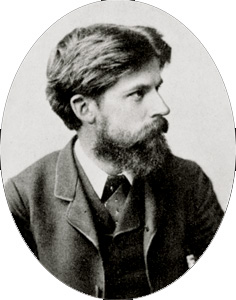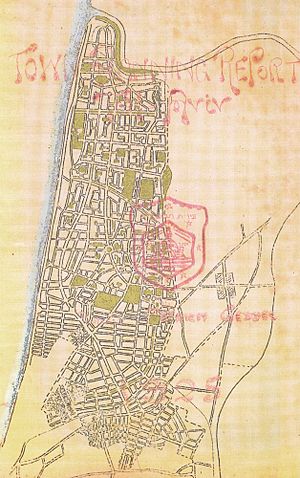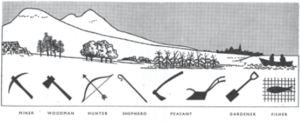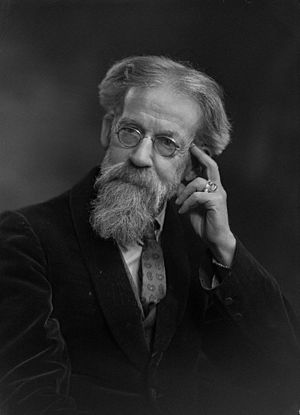Patrick Geddes facts for kids
Quick facts for kids
Sir
Patrick Geddes
FRSE
|
|
|---|---|
 |
|
| Born | 2 October 1854 |
| Died | 17 April 1932 (aged 77) Scots College, Montpellier, France
|
| Nationality | Scottish |
| Alma mater | Royal School of Mines |
| Known for | Urban planning and the term conurbation |
| Spouse(s) | Anna Geddes |
| Children | Norah Geddes and two brothers |
| Scientific career | |
| Fields | Sociology, urban planning, biology |
| Institutions | Lecturer in Zoology, University of Edinburgh (1880–1888) Professor of Botany, University College, Dundee (1888–1919) Professor of Civics & Sociology, Bombay University, India (1920–1923) |
| Patrons | John Sinclair, 1st Baron Pentland |
| Influences | Thomas Henry Huxley, Auguste Comte, Herbert Spencer, Frederic Le Play |
| Influenced | Lewis Mumford, Raymond Unwin, Frank Mears (his son-in-law), Radhakamal Mukerjee, Cebrià de Montoliu |
| Signature | |
 |
|
| Notes | |
|
Fellow of the Royal Society of Edinburgh (1880)
Co-founder of the University of Bombay Co-founder of the Sociological Society Founder of the Edinburgh Social Union Founder of the Franco-Scottish Society Planned the Hebrew University at Jerusalem Founder of the Collège des Écossais in Montpellier (1924) |
|

Sir Patrick Geddes (October 2, 1854 – April 17, 1932) was a Scottish thinker who made big contributions to how we plan cities and understand society. He was a biologist, a geographer, and a sociologist. He is famous for his new ideas in urban planning, which is about designing and managing cities.
Geddes believed in looking at how different parts of a region connect. He even created the word "conurbation" to describe a large area where many towns and cities have grown together. He also talked about "neotechnics," which was his idea for making the world better by focusing on people and nature, not just money.
He loved France and founded the Scots College in Montpellier in 1924. This was an international school. He also bought a castle nearby to create a center for studying cities.
Contents
Biography
Patrick Geddes was born in Ballater, Scotland. His father, Alexander Geddes, was a soldier. Patrick went to school at Perth Academy.
He studied science in London from 1874 to 1877, learning from famous scientists like Thomas Henry Huxley. He never finished a degree, but he learned a lot. In London, he became interested in a way of thinking called Positivism, which focuses on human progress and science. He even raised his children with these ideas. From 1880 to 1888, he taught Zoology at the University of Edinburgh.
Later, from 1888 to 1918, Geddes was a Professor of Botany at the University of Dundee.
In 1886, he married Anna Morton. They had three children: Norah, Alasdair, and Arthur. In 1917, while visiting India, Anna became very sick and passed away. Sadly, their son Alasdair also died during the war in France around the same time. Their daughter, Norah Geddes, became a landscape designer and worked on some of her father's projects. She married the architect Frank Charles Mears.
Geddes was also involved in local projects. In 1890, he helped create a teaching garden in Dundee. He was also part of the Cockburn Association in Edinburgh, which worked to protect the city's heritage.
In 1895, Geddes published a magazine called The Evergreen. It featured articles and art about nature and science.
He taught Botany at University College Dundee and later Sociology at the University of Bombay in India. He inspired others to form the Sociological Society in 1903 to share his ideas about society.
Even though he saw himself as a sociologist, his practical work in city design made him a very important figure in town planning. He greatly influenced American urban thinker Lewis Mumford.
Patrick Geddes was knighted in 1932, just before he passed away at the Scots College in France.
Town Planning Ideas
Patrick Geddes was inspired by thinkers like Auguste Comte and Frederic Le Play. He took their ideas and developed his own approach to planning cities and regions.
He believed that a city and its surrounding region were connected and should be seen as one unit. He also thought that the idea of evolution (how living things change over time) could explain how societies develop. From Le Play, he took the idea that society's basic parts are "Place, Work, Family." Geddes changed "family" to "folk" (meaning people). He believed that strong, healthy homes were the foundation for good communities.
Geddes argued that where people live (geography), how they make money (economics), and their culture (anthropology) are all linked. He saw sociology as the study of how people interact with their natural surroundings. He believed that understanding these connections was key to improving city planning.
He saw cities as complex, interconnected systems, like a flower. He thought it was wrong for modern science to focus too much on tiny details without seeing the whole picture.
Geddes talked about two types of human societies: 'paleotechnic' and 'neotechnic.'
- Paleotechnic cities were old-fashioned, focused on competition, and could destroy themselves.
- Neotechnic cities were modern, focused on working together, and could support themselves.
He believed that the destruction seen in World War I was due to too many paleotechnic ways of thinking in Europe.
Geddes saw that new technologies and city growth often led to problems like crime, sickness, and poverty. His goal was to find a balance between people and their environment to solve these issues.
Key Ideas for City Planning
"Conservative Surgery"
Geddes believed in a planning method called "conservative surgery." This meant making small, careful changes to cities to improve them, rather than tearing everything down and starting over. He focused on meeting "primary human needs."
He showed how this worked in 1886 in Edinburgh. He and his wife bought old, run-down buildings in James Court. Instead of demolishing them, they carefully improved them. They removed the worst parts, widened narrow alleys to let in more sunlight and fresh air, and restored the best buildings. Geddes thought this approach was both cheaper and more caring for the people living there.
He strongly disagreed with "sweeping clearances," where whole areas were destroyed. He felt this approach was harmful because it forced many people out, often making overcrowding worse in other parts of the city.
The "Observational Technique"
Geddes believed in observing things closely, like a scientist. He wanted to understand the connections between "place, work, and folk."
In 1892, he opened a "sociological laboratory" called the Outlook Tower in Edinburgh. This was a place where people could come and observe their city and region. He used maps, photos, and even a camera obscura (a device that projects an image of the outside world onto a screen) to help people see how different parts of society and the environment were linked.
Geddes would give tours of the tower. He would show how artists saw the city, and then how scientists like geologists saw it. The Outlook Tower showed his belief that all types of knowledge – arts, sciences, cultures – are important and connected. It's still a museum today in Edinburgh's Old Town.
The "Civic Survey"
Geddes always said, "diagnosis before treatment." This meant that before planning any changes to a city, you must first study it very carefully. This study, called a "civic survey," should look at the city's geology, climate, economy, and social life.
His early surveys of Edinburgh became a model for how to do this. He criticized planning that only focused on pretty designs without considering the local needs of the area.
Geddes's ideas were similar to later urban thinkers like Jane Jacobs. He encouraged planners to understand the unique qualities and potential of a place, rather than trying to force an ideal plan onto it from the outside.
The Regional Plan
In 1909, Geddes helped plan parts of the Zoological Gardens. This work helped him develop his "Valley Section" model for regional planning.
This model showed how nature (like plants and animals), landforms (like mountains and valleys), and human systems (like farming or fishing) all interact. It showed how different types of work are supported by different physical environments, which then affects where people settle. The goal was to show the complex connections between humans and their environment, and to encourage planning that respected these conditions.
Work in India
Geddes's success in improving slums in Edinburgh led to an invitation to India. Lord Pentland, the Governor of Madras, asked him to advise on city planning issues there. He wanted Geddes to find a way to improve cities while still respecting local traditions.
Geddes prepared an exhibition on "City and Town Planning" for India. Some of the first materials were lost when a German ship sank the transport vessel. But new materials were gathered, and an exhibit was set up in Madras in 1915.
Once in India, Geddes visited many cities. He was very impressed by Indian architecture and planning, especially how old temples were naturally part of the city. He believed this showed the city's "genius loci" – its unique spirit. Geddes openly criticized the British colonial government for being insensitive to India's historic buildings and for making drastic, destructive changes to cities.
Between 1915 and 1919, Geddes wrote many detailed reports on planning for at least eighteen Indian cities. These reports are collected in a book called Patrick Geddes in India.
His main goal was to create a "working system in India" that would fix past mistakes. He wanted to make changes that respected local culture and traditions, while also allowing for necessary development.
His principles for planning in Bombay included:
- Protecting human life and energy, not just making things look pretty.
- Following an organized development plan step-by-step.
- Buying land that was good for building.
- Helping trade and business grow.
- Saving historic and religious buildings.
- Creating a city that people could be proud of, not just copying European cities.
- Making sure all residents were happy, healthy, and comfortable, not just focusing on things for the rich.
- Controlling future growth and planning for what the city would need later.
Geddes's advice to pay attention to the social needs and unique qualities of each place is still important today, especially as many Indian cities continue to redevelop their slum areas.
Work in Palestine
Geddes also worked on projects in Palestine with his son-in-law, Frank Mears. In 1919, he designed a plan for the Hebrew University of Jerusalem.
In 1925, he created a town planning report for Tel Aviv. The city adopted his ideas, and Tel Aviv is the only city whose central area was entirely designed according to a Geddes plan.
Recognition and Legacy
Patrick Geddes's ideas spread around the world. One of his most famous admirers was the American urban theorist Lewis Mumford. Mumford said that Geddes was a "global thinker" long before it became common.
Geddes also influenced many British urban planners, the Indian social scientist Radhakamal Mukerjee, and the Spanish architect Cebrià de Montoliu.
Geddes was very interested in ecology (the study of how living things interact with their environment). He supported nature conservation and was against environmental pollution. Because of this, some historians see him as an early supporter of modern Green politics.
Researchers at the Geddes Institute for Urban Research at the University of Dundee continue to use his ideas to study city planning and how built environments affect people's well-being. In 2015, the University held an exhibition of his work to celebrate 100 years since his book Cities in Evolution was published.
Buildings
- The David Wolffsohn University and National Library, Hebrew University, Jerusalem. Designed by Patrick Geddes, Frank Mears, and Benjamin Chaikin, opened in 1930.
Published Works
- The Evergreen: A Northern Seasonal (1895/96)
- City Development, A Report to the Carnegie Dunfermline Trust (1904)
- The Masque of Learning (1912)
- Cities in Evolution (1915)
- The life and work of Sir Jagadis C. Bose (1920)
- Biology (1925) with J.A. Thomson
- Life: Outlines of General Biology (1931) with J.A. Thomson
See also
 In Spanish: Patrick Geddes para niños
In Spanish: Patrick Geddes para niños
- Scottish Renaissance
- Geddes Island
- Lady Stair’s House
- Ramsay Garden
- James Cadenhead, a Scottish artist who worked with Geddes.
- List of urban theorists
- Pro-Jerusalem Society (1918-1926) - Geddes was a member of its council.



